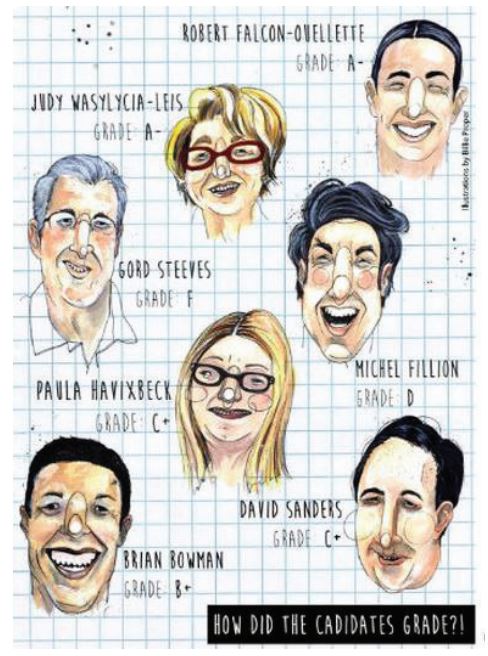What sets municipal elections apart from those at other levels of government is that candidates are less constrained to toeing the party line.
Municipal elections give an opportunity to bring forth creative ideas in a way that other levels of government don’t.
While the party structure’s influence on the provincial and federal levels of Canadian government limits individual candidates’ capacity for candour, municipal elections are generally expected to be more open, with a greater flow of ideas coming out of increased freedom of expression for candidates.
The opportunity presented by an open and independent municipal election is accentuated this year because this is arguably the first chance for a major change in the makeup of city council in several election cycles.
With this in mind, Winnipeg’s 2014 municipal election is fast approaching. The early polls opened Sept. 29.
The election will be an opportunity for Winnipeggers to select people to represent them at city hall and chart the path of the city for the next four years.
However, this opportunity is threatened by a number of barriers to meaningful participation and a fair election.
These barriers include incumbent advantage, a first-past-the-post electoral system, and a number of more broad social and economic barriers that prevent full participation for sections of the population.
Incumbent advantage
Incumbent mayors, city councillors, and school trustees are almost impossible to knock off and this time around the mayor and four councillors have stepped out of the race.
Veteran councillor Dan Vandal has won, through acclamation, the federal nomination of the Liberal party in St. Boniface for the looming 2015 federal election.
Councillor Justin Swandel has decided not to run again after a turbulent final term in which he butted heads with members of the media and his fellow councillors.
Scott Fielding has secured the nomination of the Progressive Conservative party in the provincial constituency of Kirkfield Park.
And after only one term on city council, Paula Havixbeck has jumped into the race for mayor.
Lastly, Sam Katz, Winnipeg’s three-term mayor, has decided not to run.
Russ Wyatt, councillor for Transcona, was running in a one-on-one race against labour-endorsed Ray Ulasy, but decided to exit the race on Sept. 12 announcing that, like Vandal, he would be seeking a Liberal nomination for the upcoming federal election.
After withdrawing his nomination papers on the Friday afternoon, Wyatt announced Sept. 16—the last day for candidates to submit their nomination papers—that he had changed his mind and would be re-entering the municipal election.
Perhaps someone pointed out the Liberals haven’t won the riding since its inception in 1998.
Or that both the Conservatives and the NDP have already selected candidates with similarly strong brand recognition.
Or that Wyatt’s personal brand may not be as popular in the much larger federal riding as it has been in the relatively small municipal ward he has done so well in.
Wyatt’s decision highlights one fact of political life in Winnipeg – incumbents have an inherent advantage.
Running one more time is always a safe bet, and this isn’t something new.
Simply carrying name recognition is an asset in any political campaign. And name recognition just happens to be something that comes with having your name and face etched into dozens of bus stop benches, garbage bins, and basically any other public property associated with city services that’s nailed down.
More specific to Winnipeg is the lack of election laws regulating spending and spending announcements during the election cycle.
Last week the Winnipeg Free Press’ Bartley Kives reported on major spending announcements by incumbent councillors Jeff Browaty and Mike Pagtakhan.
On Sept. 22, just one month before the election, Jeff Browaty and Mayor Sam Katz announced a $520,000 investment in Chornick Park, a park located in Browaty’s ward of North Kildonan.
On Sept. 19, Pagtakhan announced $250,000 worth of investment in Dufferin Park.
The WFP’s editorial staff have also brought attention to Brian Mayes’ online promotion of ward spending over the last several months.
This sort of spending announcement wouldn’t be allowed in a provincial election.
Section 92 of the Elections Financing Act bars any provincial government department or crown agency from advertising or publishing any information about its programs or activities for the 90 days prior to an election.
While Browaty argued that the announcement of public expenditures hasn’t given him any sort of advantage in the election, Pagtakhan ceded that it may offer incumbents an advantage but decided to do it anyways.
First-past-the-post
A first past-the-post electoral system—like the one we currently have for all levels of government—exacerbates the problem of unfair incumbent advantage and discourages a variety of candidates from signing up out of fear of “vote-splitting,” and as a result prevents the emergence and support for candidates with unconventional ideas.
Vote splitting is when two or more candidates who share some values or are generally from one end of the political spectrum split supporters, enabling another candidates to obtain a plurality of votes.
Fear of vote-splitting veers voters toward candidates who already have popular support and away from less popular and less recognized candidates who they might otherwise support.
At its worst a fear of vote-splitting keeps candidates from running altogether.
The most common alternative to first-past-the-post is a ranked ballot system.
Under a ranked ballot system, voters rate their preference of candidates from first to last.
The candidate with the lowest number of first votes is eliminated and their votes are transferred to the next favourite candidate on the voters list.
This process continues until one candidate has the majority of votes.
In the 2010 municipal election former NHL player, and centre-right candidate, Thomas Steen won his Elmwood – East Kildonan council seat with 33.7 per cent of the vote.
Shaneen Robinson and Rod Giesbrecht, two left-leaning candidates, ran and split the remaining vote almost equally between them in the historically left-leaning corner of the city.
The final count was Steen – 3,921, Robinson – 3,705, Giesbrecht – 3,501, with two other candidates, Gordon Warren, and Nelson Sanderson, each garnering a couple hundred votes.
It’s not hard to imagine how ranked ballots might have changed the outcome of that election.
Warren and Sanderson’s votes would have been split up between the other three candidates and then, depending on who held the lead between Robinson and Giesbrecht, one of them would be eliminated, their support most likely swinging to the other.
The Daniel McIntyre ward may have shifted as well under a ranked ballot system. Long-time incumbent Harvey Smith won the seat with only 36.2 per cent of the vote in 2010.
Although Smith is considered a progressive voice at city hall, he’s also been councillor for 22 years.
Votes in Daniel McIntyre were similarly split amongst younger, alternative progressive candidates in the ward – Cindy Gilroy-Price and Keith Bellamy .
Even in districts where it may not have had an immediate effect on election outcomes, such as Russ Wyatt’s 83.4 per cent decimation of upstart Vlad Kowalyk in Transcona, or Gord Steeves’ 82.3 per cent hammering of Harry Wolbert in St. Vital, ranked ballots would create an opportunity for more alternative candidates to run.
Opposition to the incumbent wouldn’t be so fearful of a monolithic candidate and would be more willing to field numerous opposition candidates, expanding discourse within the election and ensuring more voices are heard.
Half of the power of any election is not just in selecting a representative, but creating a forum for new ideas on how a society might operate or how a community might organize itself.
Our current system of voting doesn’t just narrow our choice of candidates, it narrows the discourse around what our future might look like. And a broader discourse is something Winnipeg badly needs.
The current municipal elections have been largely devoid of creative ideas.
Although some would argue that Steeves has been very creative in some of his campaign promises—see: aerial drones—candidates are more scared at the prospect of alienating voters by announcing what they stand for than they are of not getting any votes because they haven’t said anything.
Instead of a discussion about who brings the best ideas to the fore, we’re stuck choosing between well-established candidates who all want to “invest in infrastructure” and “increase transparency.”
Having followed the election closely, I’m hard-pressed to think of a candidate who doesn’t want to invest in infrastructure or has taken a lukewarm position on increased transparency.
Beyond electoral barriers
These are only the first and most plainly obvious barriers to fair elections.
They address electoral issues but not any of the broader social issues that act as barriers.
They don’t fully address why women, people of colour, and other groups are underrepresented amongst our candidates and our elected officials.
In late July, CBC published an article pointing out that only five of Winnipeg’s then 39 city council candidates were women.
Since then the total number has increased to nine out of 59, or 15 per cent.
Less than half of the wards even have a woman running.
Seeing a turnaround in this sort of underrepresentation will require a broader, more concerted effort in organizing and won’t be limited to actions leading up to elections.
Electoral reforms aren’t a fix-all solution but they are necessary, and one part of creating a more fair and representative city hall.




